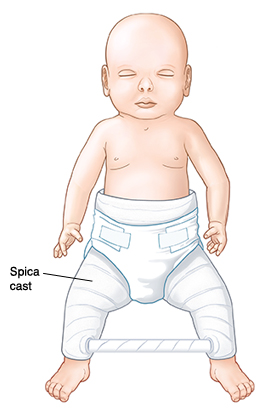When Your Child Needs a Spica Cast
When Your Child Needs a Spica Cast
Your child needs a spica cast. This is a cast that covers the child’s lower body. It is used to treat problems such as fractures (broken bones) in the hips or thighs. A spica cast reaches from the chest over the hips and down one or both legs. It has a cutout at the groin for toileting. A bar may connect the legs to make the cast more stable. A spica cast is applied by an orthopedist, a doctor specializing in treating bone and joint problems. This is often done in an operating room. Your child will wear the cast for 4 to 12 weeks.
When is a spica cast needed?
A spica cast is used to stabilize and protect the hip or thigh area for a set time. This helps problems or injuries in these areas heal. A spica cast may be used after the following: 
-
A thighbone (femur) fracture
-
Hip or pelvis problems or fractures
-
Dislocation (pushing out of place) of the hip joint
-
Certain surgeries (such as a tendon release)
Caring for your child
You will be given specific instructions for caring for your child and the spica cast. Here are some guidelines:
-
Inspect the cast and your child regularly for:
-
Sharp areas or rough spots near skin.
-
Skin that is red, irritated, or sore.
-
A skin rash around or under the cast.
-
Skin that is numb or changes color.
-
-
Keep the cast dry. Don’t let water get under the cast. Bathe and clean your child with sponge baths, as instructed. Clean the groin area carefully.
-
Tape around the edges of the groin opening of the cast. This helps the cast stay clean. Many parents use moleskin or duct tape.
-
Diaper your child as instructed by the healthcare provider. Often, a diaper is put on underneath the opening of the spica cast. Then another larger diaper is placed over the cast. A woman’s menstrual pad (sanitary napkin) can be used on the inside diaper to increase absorbency. Change diapers often to prevent skin breakdown and soiling of the cast. You will likely have to help a toilet-trained child use the toilet. A bed pan or urinal (for boys) may be needed for older children.
-
Just after the cast is put on, limit your child’s activity to let the injury stabilize. Gentle activities are encouraged. These include such things as board games, reading, listening to music, puzzles, crafts, and video games. Your child’s healthcare provider can give you specific activity guidelines for your child while the cast is in place.
-
Put your child’s clothing on over the cast. Loose or larger-sized clothing works best, such as large sweat pants or one-piece bodysuits for infants. Larger clothing can be cut and velcro applied to ease in dressing the child.
-
Change a child's position often, about every 2 to 4 hours. Consider using a bean bag chair, pillows, or a recliner for ease of positioning the child.
-
To get around, older children may need a reclining wheelchair, which you can get at a medical supply store. Younger children can be placed in an adjustable stroller or wagon. Remember to always use safety straps.
Call your child’s healthcare provider if your child has any of the following:
-
Fever (see “Fever and children” below)
-
Chills
-
Skin around the cast is red, irritated, or sore
-
The toes change color or feel very cool to touch
-
Your child can't move or wiggle his or her toes
-
A skin rash develops near or under the cast
-
Your child complains that a spot under the cast hurts or burns
-
Your child’s toes are numb or tingly
-
Your child has pain that is not eased by raising the legs and using acetaminophen, or other prescribed pain medicine
-
The cast develops any breaks, cracks, or sharp spots
-
If something falls down into the cast and becomes stuck
-
The cast gets wet or very dirty, or the crotch opening gets soiled with stool or urine
Fever and children
Always use a digital thermometer to check your child’s temperature. Never use a mercury thermometer.
For infants and toddlers, be sure to use a rectal thermometer correctly. A rectal thermometer may accidentally poke a hole in (perforate) the rectum. It may also pass on germs from the stool. Always follow the product maker’s directions for proper use. If you don’t feel comfortable taking a rectal temperature, use another method. When you talk to your child’s healthcare provider, tell him or her which method you used to take your child’s temperature.
Here are guidelines for fever temperature. Ear temperatures aren’t accurate before 6 months of age. Don’t take an oral temperature until your child is at least 4 years old.
Infant under 3 months old:
-
Ask your child’s healthcare provider how you should take the temperature.
-
Rectal or forehead (temporal artery) temperature of 100.4°F (38°C) or higher, or as directed by the provider
-
Armpit temperature of 99°F (37.2°C) or higher, or as directed by the provider
Child age 3 to 36 months:
-
Rectal, forehead, or ear temperature of 102°F (38.9°C) or higher, or as directed by the provider
-
Armpit (axillary) temperature of 101°F (38.3°C) or higher, or as directed by the provider
Child of any age:
-
Repeated temperature of 104°F (40°C) or higher, or as directed by the provider
-
Fever that lasts more than 24 hours in a child under 2 years old. Or a fever that lasts for 3 days in a child 2 years or older.
Updated:
January 17, 2020
Sources:
Reed, C. SPica Cast Care A Collaborative Staff-Led Education Initiative for Improved Patient Care (2011); 30(6); pp. s353-358
Reviewed By:
Bass, Pat F. III, MD, MPH,Bass, Pat F. III, MD, MPH